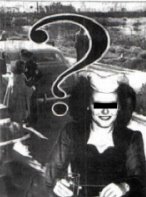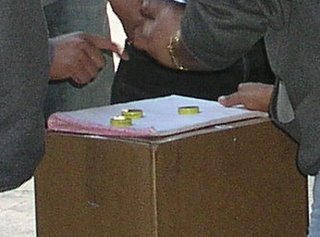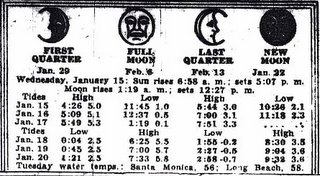Page 7
What’s this? Another day on Page 7? Theological scholars don’t scrutinize the Bible this carefully and this is a book you could read in a few hours waiting for a plane at LAX. Don’t give up, we’re closing in on Page 8. I warned you from the beginning that this would be tedious. But you asked why I don’t read Black Dahlia books. This is why. It’s painful.
In the small hours after midnight, Bobby Jones, a young man in his early teens, wheeled his bicycle through a vacant lot near Thirty-Ninth Street and Norton Avenue in Leimert Park.
This is the elusive story about the Boy on the Bicycle at the crime scene. It’s one of Will Fowler’s yarns and the original version goes like this: Will was at the crime scene with photographer Felix Paegel (Will usually threw in lots of distracting details about what kind of flashbulbs Paegel used to divert attention from the fact that Will didn’t have a copy of the picture Paegel supposedly took of him with the body. “And nooooooobody around,” Will always said. “All alooonnnnne.”
In his often-told tale, the cops showed up, pulled their guns and Will explained who he was, suggesting they go talk to the Boy on the Bicycle who was standing nearby.
My first hint that anything was wrong with this was when I told Will I’d found one of the first two police officers at the scene and was going to interview him (which I did). Will became extremely uncomfortable and said something like: “Gee, (nervous laugh) I wonder if he’ll remember pulling his gun?”
When I sat down with the officer, Wayne Fitzgerald, he said: “Bullshit!” And then to make sure I got the point, he said it again: “Bullshit!”
And as time proved, Will wasn’t the first reporter at the crime scene. It took me years to untangle the truth and by then Will was in terrible shape, dying of cancer and in mental decline. One time I was coming over to visit and asked if there was anything I could bring him. Will asked me to pick up some Kleenex and toilet paper. At his apartment on Stern in Sherman Oaks, Will told me where to put the items and when I opened the cabinet, the shelves were full of Kleenex and toilet paper. He was embarrassed and said: "I guess I forgot."
He got even worse. Before his death in 2004, Will called up and said he’d been institutionalized for six months because he had become violent with someone (Will was a boxer—or at least claimed he was a boxer in his early years. His father, Gene, was friends with Jack Dempsey so I assume at least some part of his boxing stories is true). I never had the heart to call him after that.
I have never located the Boy on the Bicycle, but it isn’t for lack of trying. He’s never mentioned in any of the news reports or documents in the Los Angeles County district attorney’s files.
Here’s Will’s version of the Boy on the Bicycle from “Reporters,” Page 75: “As [the officers] started their investigation, I pointed toward Crenshaw. There was a pre-teenager straddling his bike a block away. 'Why don’t you question that kid over there? Maybe he knows something,' I said. I was anxious to get to a phone.”
He next turns up in “Severed,” Page 1:
“Shortly after six o’clock that morning, a boy walked his bicycle through the weeds of a stretch of vacant lots south of Hollywood.”
I read something like that and I just sigh. Leimert Park, despite what you read elsewhere is nowhere near Hollywood.
“Severed” continues: “The boy slowed down to glance back at the sound of a car, an older black sedan, possibly a Ford. The early morning light reflected on the windshield and he couldn’t see anyone behind the wheel…. Almost late for his paper route, the boy gave no further thought to that lone car on Norton. But soon he would find out that someone—whoever had been in that car—had left something so terrible in the vacant lot that for the rest of his life the boy would remember that windshield. He would try to picture a face behind the glass but he never could see one.”
Note that Will puts the Boy on the Bicycle a block from the crime scene on Crenshaw at the time the body is found while John Gilmore, in “Severed,” rolls the clock back to dawn and puts him on Norton Avenue. Wolfe places the Boy on the Bicycle even earlier, “in the small hours after midnight.” And “Severed” never identifies him or gives his age, while Will gives his name as Bobby Jones and calls him a preteen. Wolfe, however, makes him a bit older.
But of course there’s more to the story. Let’s flip back to Todd (also known as Tod) Faulkner’s 1971 feature in The Times. Aha! It’s our friend, the Boy on the Bicycle. But wait. Here’s what Faulker says:
"[Harry] Hansen remembers that reporters and photographers were already on the scene when he and [Finis] Brown arrived. So was a man who had been out walking his dog. So was Bobby Smith, an 11-year-old from down the street who usually played in this field and who now sat quietly astride his bicycle and watched and would remember."
Nothing about a paper route, nothing about him seeing a car, nothing about spending the rest of his life trying to visualize the face behind the windshield of the car, as portrayed in “Severed.” Faulker wraps up the story of the Boy on the Bicycle by saying: “Bobby Smith, the 11-year-old who sat and watched it that morning from his bike, works for a motor home company out in Van Nuys.”
I’ve never found this kid, nor the motor home company in Van Nuys where he supposedly worked. The Times did publish his picture, however.
Here’s the genealogy of the Boy on the Bicycle story:
1971, Todd Faulkner, Los Angeles Times (making his debut as Bobby Smith)
1991, Will Fowler, “Reporters” (name changed to Bobby Jones)
1994, John Gilmore, “Severed” (not identified)
2006, Donald H. Wolfe, “Mogul” (using the name Bobby Jones), crediting “Severed” and a 2003 interview with Will, who was barely coherent at that point in his life—at least when I spoke with him.
Fortunately “Black Dahlia Avenger,” either misses or ignores this story, or the Boy on the Bicycle (evil genius George Hodel in disguise perhaps?) would be swept up in the vast, shadowy conspiracy in which the LAPD concealed dozens of murders because Dr. Hodel knew who was walking around Los Angeles with a case of VD. I hope that sounds as absurd to you as it does to me.
So how does the story go from Will Fowler to John Gilmore? Through Mary Pacios, author of “Childhood Shadows.” Will describes his encounter in “Reporters,” Pages 88-91:
“Then there was a 13-year-old boy named John Gilmore, the son of a Los Angeles policeman at the time of the Dahlia murder. The elder had little to do with the case then. But after many years of listening to his father recount the unsolved slaying over and over, young John finally published a Black Dahlia piece in what is known in the industry as a ‘junk magazine.’ ”
“It was my impression that John finally succumbed to the fictional bizarre when he claimed to have met Elizabeth [Short’s] killer, ‘Mr. Jones.’ And… heavens to Betsy… John’s informant, who led him to Mr. Jones, was no other than the reliable source: nationally respected ‘Mr. Smith.’ ”
Will continues to describe meeting Mary Pacios, (then Mary Humphrey).
“As a down payment in order to more closely study this woman who desperately yearned for some kind of recognition, I offered to guide her along the difficult route of writing a first book. In good faith, I handed her my Dahlia chapter, the Crane scenario [too much Dahlia insider stuff even for me—lrh] some photo negatives and John Gilmore’s erroneous magazine piece. This, with the proviso that the material would serve only as a guide, and that she would not publish or publicly refer to any of the same until after ‘Reporters’ was published.”….
“It wasn’t until 1990 when Mary sent me her final letter. She wrote that she and John Gilmore had met and the two were going to collaborate on a Dahlia book.”
“My God,” I thought, “now two confused Dahlia nonentities have coupled.”
“Some time later I happened to catch the two on a television talk show where they starred as the ultimate Black Dahlia authorities. They had unblushingly enlarged on their fancies. Now John claimed the murderer had confessed to him before death, and not to police. And Mary had raised Elizabeth in her social station, having had her double-dating with Marilyn Monroe and appearing at fashionable Hollywood nightclubs with the likes of Franchot Tone.”
Does the Boy on the Bicycle really exist? The Times ran a picture of somebody in 1971. But the smart money says he is fiction.
The larger question, however, is why Wolfe draws on "Severed" as well Will Fowler and "Reporters," which is so dismissive and sarcastic about John Gilmore. Since I'm blogging this as I read in real time, I don't know the answer. Maybe we'll find out and maybe not.
Whew. I have to go for a walk. But as promised we are on Page 8.
Labels: Black Dahlia, Books and authors, Fashions, Hollywood, Homicide, LAPD, Nightclubs, Photography, Streetcars
 Look what I found while watching the opening of "Some Like It Hot." Why it's signage for a 1950s Standard gas station. Hey isn't that going to be in the shot? Naw, don't worry about it.
Look what I found while watching the opening of "Some Like It Hot." Why it's signage for a 1950s Standard gas station. Hey isn't that going to be in the shot? Naw, don't worry about it.




















